Claude Forthomme's Blog, page 41
August 29, 2013
Amazing Italy: A Historic Winemaker Buils a Groundbreaking $100 million Cantina
Antinori, the ancient family that has been making wine in the Chianti region since the 1500s, has just built a new groundbreaking winery in Bargino, near Florence, complete with a 200-seat auditorium, a museum, a restaurant and a shop. It is rapidly attracting the attention of architects and the public since it opened earlier this year.
A jewel of contemporary design covering 50,000 square meters (540,000 square feet), it is the brainchild of Florentine architects (Studio Archea) who felt that wine was the "oil resource", the "black gold" of Tuscany and deserved a monument to celebrate it.They dug up the hill over an area of 35 acres, sinking in 17,000 piles to stabilize the construction and covering everything up again to ensure the building would blend into the landscape.
It ended up costing almost the double of what was originally planned, some €82 million ($110 million).
The result is striking.
First, see how the building respects its surrounding landscape. Here it is still under construction but close to being finished (an Archeo aerial photo):
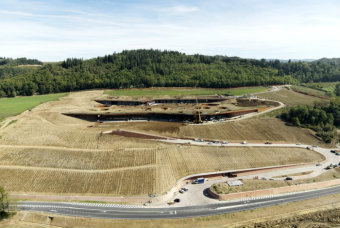
It's literally nestled into the hillside. Groundbreaking indeed!
Here's the entrance, with the spectacular corkscrew staircase leading down to the parking space under the building - and a corkscrew design for a winery seems particularly apt:
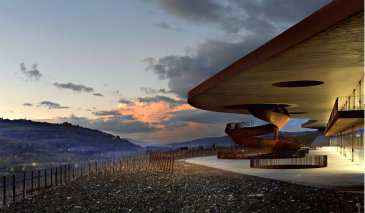
Here are the tasting rooms cantilevered over the wine cellars, you've never tasted wine in such surroundings, floating above the wine barrels:
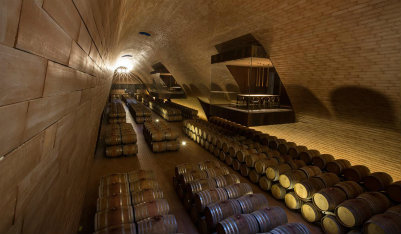
There's a restaurant on top with panoramic views on the countryside - lean and modern, nothing but local wood:
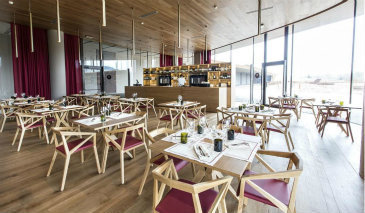
Well, I'm not sure I like the furniture, it reminds me too much of Ikea/Scandinavian-style stuff...but it's a minor point.
It doesn't detract from the overall feel of break-through innovation and it goes to show that Italy is not just Renaissance villas and can renew itself.
Undoubtedly, it also takes special clients with deep pockets and the courage to follow their architects' iconoclastic suggestions...
For more about it, read the New York Times' Michael Kimmelman's excellent article, here.
Source of photos: Cantina Antinori's website, click here to visit.










A jewel of contemporary design covering 50,000 square meters (540,000 square feet), it is the brainchild of Florentine architects (Studio Archea) who felt that wine was the "oil resource", the "black gold" of Tuscany and deserved a monument to celebrate it.They dug up the hill over an area of 35 acres, sinking in 17,000 piles to stabilize the construction and covering everything up again to ensure the building would blend into the landscape.
It ended up costing almost the double of what was originally planned, some €82 million ($110 million).
The result is striking.
First, see how the building respects its surrounding landscape. Here it is still under construction but close to being finished (an Archeo aerial photo):

It's literally nestled into the hillside. Groundbreaking indeed!
Here's the entrance, with the spectacular corkscrew staircase leading down to the parking space under the building - and a corkscrew design for a winery seems particularly apt:

Here are the tasting rooms cantilevered over the wine cellars, you've never tasted wine in such surroundings, floating above the wine barrels:

There's a restaurant on top with panoramic views on the countryside - lean and modern, nothing but local wood:

Well, I'm not sure I like the furniture, it reminds me too much of Ikea/Scandinavian-style stuff...but it's a minor point.
It doesn't detract from the overall feel of break-through innovation and it goes to show that Italy is not just Renaissance villas and can renew itself.
Undoubtedly, it also takes special clients with deep pockets and the courage to follow their architects' iconoclastic suggestions...
For more about it, read the New York Times' Michael Kimmelman's excellent article, here.
Source of photos: Cantina Antinori's website, click here to visit.










Published on August 29, 2013 00:53
August 28, 2013
Syria: What's the Rush to Enter the War?
There is no doubt that chemical attacks are a crime against humanity, an abomination that should be contained and punished.
But why the rush to launch military strikes against Syria?
It took US President Bush Senior five months after the invasion of Kuwait to start the war on Iraq.
 Burning oilfield during Operation Desert Storm, Kuwait (Photo credit: Wikipedia)
Burning oilfield during Operation Desert Storm, Kuwait (Photo credit: Wikipedia)
I'm not suggesting we should wait five months but we should at least put our case together in a strong, legal way. With the United Nations and the international community at large.
So far, the countries supporting war besides the US are only two: France and Britain. Germany and Italy lean towards seeking UN Security Council approval first - which is no doubt going to be difficult given Russia's position of unfailing support to Syria. Not to mention China's. Still, it should be tried.
I just can't understand why our politicians act like warmongers. It is fine to be morally indignant about chemical warfare, who isn't?
But to launch yet another series of air strikes à la Lybia-style when we know that the rebels on the ground are mostly violent muslim extremists, is that wise?
Or is it a way for Mr. Cameron and Mr. Hollande to draw people's attention away from the economic problems both countries are facing? Guns as a solution to bread and butter issues are a classic...
What do you think?
Related articles
 Nathan Gardels: Hans Blix: Whether Obama in Syria or Bush in Iraq, The US Is Not the World Police(huffingtonpost.com)
Nathan Gardels: Hans Blix: Whether Obama in Syria or Bush in Iraq, The US Is Not the World Police(huffingtonpost.com)
 Biden: No doubt Syria regime used nerve agent(aljazeera.com)
Biden: No doubt Syria regime used nerve agent(aljazeera.com)
 US, allies going around UN to justify Syria action(thestate.com)
US, allies going around UN to justify Syria action(thestate.com)
 William Hague: this is a moment for democratic nations to live up to their values(telegraph.co.uk)
William Hague: this is a moment for democratic nations to live up to their values(telegraph.co.uk)










But why the rush to launch military strikes against Syria?
It took US President Bush Senior five months after the invasion of Kuwait to start the war on Iraq.
 Burning oilfield during Operation Desert Storm, Kuwait (Photo credit: Wikipedia)
Burning oilfield during Operation Desert Storm, Kuwait (Photo credit: Wikipedia)I'm not suggesting we should wait five months but we should at least put our case together in a strong, legal way. With the United Nations and the international community at large.
So far, the countries supporting war besides the US are only two: France and Britain. Germany and Italy lean towards seeking UN Security Council approval first - which is no doubt going to be difficult given Russia's position of unfailing support to Syria. Not to mention China's. Still, it should be tried.
I just can't understand why our politicians act like warmongers. It is fine to be morally indignant about chemical warfare, who isn't?
But to launch yet another series of air strikes à la Lybia-style when we know that the rebels on the ground are mostly violent muslim extremists, is that wise?
Or is it a way for Mr. Cameron and Mr. Hollande to draw people's attention away from the economic problems both countries are facing? Guns as a solution to bread and butter issues are a classic...
What do you think?
Related articles
 Nathan Gardels: Hans Blix: Whether Obama in Syria or Bush in Iraq, The US Is Not the World Police(huffingtonpost.com)
Nathan Gardels: Hans Blix: Whether Obama in Syria or Bush in Iraq, The US Is Not the World Police(huffingtonpost.com) Biden: No doubt Syria regime used nerve agent(aljazeera.com)
Biden: No doubt Syria regime used nerve agent(aljazeera.com) US, allies going around UN to justify Syria action(thestate.com)
US, allies going around UN to justify Syria action(thestate.com) William Hague: this is a moment for democratic nations to live up to their values(telegraph.co.uk)
William Hague: this is a moment for democratic nations to live up to their values(telegraph.co.uk)









Published on August 28, 2013 00:06
August 27, 2013
Elite Breeding is Flourishing Around the World
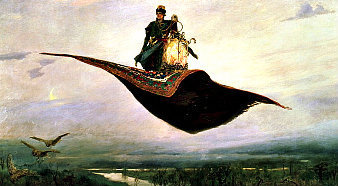
A Reuters Breaking Views columnist, Edward Hadas, just published an interesting piece on the spread of nepotism around the world. It's not just in China where "elite breeding" is a national institution but in all developed countries: children of the rich are the ones getting all the good jobs.
Now, I imagine you are wondering why this should be considered as news. It's been that way since the beginning of time and only after the industrial revolution and the rise of universal education did that start to change - just a little bit. But now, we are witnessing a throwback to earlier times.
The Bo Xilai trial is one symptom. The on-going US Securities and Exchange Commission's investigation into JPMorgan Chase hiring practices in China is another (the charge here is bribery). But as I said, it's not just China. Many studies show that social mobility is declining in most developed countries.
This is, as Edward Hadas calls it, "the resurgence of family-as-destiny" economies. For more on it, read his piece here.
My take is that there's nothing new under the sun. Italy where I live is a country where family businesses are the norm and have been for generations - most notably the Fiat in Torino.
The One Percent begets the One Percent.
Those who live in the periphery, the so called "mass affluent", strive to give their children the means to "break through", sending them to the "right" summer camps and universities...
But if the fall of the middle class continues and the current Big Recession doesn't end soon, I'm afraid the world will look very much like the one I depict in my Forever Young serial novel where all the technological advances go to benefit the ultra rich, those I have called the "Masters of the Future"...
What do you think, is "family-as-destiny" the society of the future?
Image:Victor Vasnetsov art, "Flying Carpet", 1880.










Published on August 27, 2013 02:34
August 26, 2013
The Way We Were 600 Years Ago: Separated!
Around 1440, San Bernardino preached to crowds in Siena, Italy, and a local painter recorded the event:

I apologize for the quality of the image, I took it on the go in the museum next to the cathedral. But I wanted to share it with you because it shows something amazing. Did you notice it?
Yes, all the women are on the left separated from all the men on the right! There's a barrier built between them.
And note further: all the women are covered from head to toe, you can't see their faces . Yet you do see the faces of the men, the painter made an effort to show them!
That was (almost) 600 years ago - some 25 generations have gone by since. That's how long it has taken the West to achieve gender equality...
How long will it take the Muslim world? They started off well two years ago with the Arab Spring...alas, it seems to have turned into an Arab Winter.
Still, I have great hopes that the evolution will be faster, they have an advantage over the West: they know which way the road goes, at least some of them do, the young ones...











I apologize for the quality of the image, I took it on the go in the museum next to the cathedral. But I wanted to share it with you because it shows something amazing. Did you notice it?
Yes, all the women are on the left separated from all the men on the right! There's a barrier built between them.
And note further: all the women are covered from head to toe, you can't see their faces . Yet you do see the faces of the men, the painter made an effort to show them!
That was (almost) 600 years ago - some 25 generations have gone by since. That's how long it has taken the West to achieve gender equality...
How long will it take the Muslim world? They started off well two years ago with the Arab Spring...alas, it seems to have turned into an Arab Winter.
Still, I have great hopes that the evolution will be faster, they have an advantage over the West: they know which way the road goes, at least some of them do, the young ones...










Published on August 26, 2013 01:13
August 23, 2013
The Real Victims in Egypt and Elsewhere in the Muslim World? The Women!

An Italian blogger just posted about the sorry state of women in the Muslim world, you can read his post (in Italian) here.
It is a tragedy and one that is too often overlooked. The Arab Spring has turned to winter and the women are the real losers...
Avaaz has recently tried to awaken consciences in the West, reporting, inter alia, on Sahar Gul's horrendous experience. Sahar (see picture) is a 15 year old girl whose in-laws imprisoned her, starved her, beat her with a hot steel rod, to force her to prostitute herself.
The petition, posted by Avaaz on July 18 2013 had garnered only 716 signatures the last time I looked - it needs to reach 750 signatures for the petition to be sent to the Afghan authorities. To read story and sign petition, please click here.
I just signed it.
Honestly, something needs to be done. I don't think women in the West should go on ignoring what is happening to their sisters in the Muslim world...As Avaaz says, STOP THE ANTI-WOMEN GAG RULE!
And I'm very grateful to my Italian fellow blogger, Giuseppe di Linguaglossa, for drawing my attention to this!










Published on August 23, 2013 02:42
August 22, 2013
Misunderstood Art: Jamie Wyeth's Masterpiece in a Closet
In Italy, the best museums are ignored by tourists, in America, a fantastic portrait is relegated to a closet. Only now, it's coming out of obscurity because suddenly the public realizes that Jamie Wyeth, the gifted son of Andrew Wyeth is as great an artist as his father.
Done in 1963 when Jamie Wyeth was still a young upstart, it is the portrait of a famous woman doctor, universally considered a pioneer and the founder of pediatric cardiology, Helen. B. Taussig (for her biography, click here). She was a strong woman, extraordinarily bright and gifted, and it shows. The portrait is an amazing psychological analysis as well as esthetically remarkable - the colors, the rendering of the flesh, the striking blue eyes, the fuzzy hair:
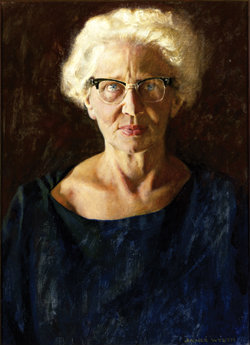
And here's the portrait's story in the Johns Hopkins Magazine published in 2011 (it shows the above photo of the portrait), to see click here.
This week the New York Times picked the story up again as now the artistic value of the portrait is finally recognized because Jamie Wyeth has finally achieved fame, see here.
Why all the fuss?
Because, back in 1963, the good doctor and her friends at Johns Hopkins didn't feel the painter had done justice to her. She was universally seen as a good woman - and she was, no doubt about that - but the painter had caught something that was not so visible to everyone: her determination, her strength, her keen intelligence and capacity to observe/analyze, and also the angst that inevitably accompanies pioneering work. What eyes!
Compare the portrait to her official photo (on Wikipedia and elsewhere):

See what I mean? The portrait tells a real story, the photo tells a cliché version.
Even a well done but more conventional portrait (made in 1981 by Patric Bauernschmidt - it's shown in the NYT article) misses the point about Dr. Taussig:

What do you think? Is Jamie Wyeth's a bad portrait or a good one from an artistic point of view?
Wyeth has made his reputation as a landscape, still life and animal artist rather than as a portraitist (to see his work, click here)...He complained that people do not see themselves as the artist does and therefore did very few portraits - and I can't disagree with him on that...I've tried my hand at portraits, and there's no doubt that a portrait is by far exceedingly difficult to pull off successfully - and very rarely to the satisfaction of the sitter!
By the way, that is also a point I make in A Hook in the Sky, my novel about a retiree-turned-artist to the dismay of his wife. Portraits are psychological exercises, tough to carry out and particularly tough when it's a self-portrait: it's very hard to see oneself objectively!










Done in 1963 when Jamie Wyeth was still a young upstart, it is the portrait of a famous woman doctor, universally considered a pioneer and the founder of pediatric cardiology, Helen. B. Taussig (for her biography, click here). She was a strong woman, extraordinarily bright and gifted, and it shows. The portrait is an amazing psychological analysis as well as esthetically remarkable - the colors, the rendering of the flesh, the striking blue eyes, the fuzzy hair:

And here's the portrait's story in the Johns Hopkins Magazine published in 2011 (it shows the above photo of the portrait), to see click here.
This week the New York Times picked the story up again as now the artistic value of the portrait is finally recognized because Jamie Wyeth has finally achieved fame, see here.
Why all the fuss?
Because, back in 1963, the good doctor and her friends at Johns Hopkins didn't feel the painter had done justice to her. She was universally seen as a good woman - and she was, no doubt about that - but the painter had caught something that was not so visible to everyone: her determination, her strength, her keen intelligence and capacity to observe/analyze, and also the angst that inevitably accompanies pioneering work. What eyes!
Compare the portrait to her official photo (on Wikipedia and elsewhere):

See what I mean? The portrait tells a real story, the photo tells a cliché version.
Even a well done but more conventional portrait (made in 1981 by Patric Bauernschmidt - it's shown in the NYT article) misses the point about Dr. Taussig:

What do you think? Is Jamie Wyeth's a bad portrait or a good one from an artistic point of view?
Wyeth has made his reputation as a landscape, still life and animal artist rather than as a portraitist (to see his work, click here)...He complained that people do not see themselves as the artist does and therefore did very few portraits - and I can't disagree with him on that...I've tried my hand at portraits, and there's no doubt that a portrait is by far exceedingly difficult to pull off successfully - and very rarely to the satisfaction of the sitter!
By the way, that is also a point I make in A Hook in the Sky, my novel about a retiree-turned-artist to the dismay of his wife. Portraits are psychological exercises, tough to carry out and particularly tough when it's a self-portrait: it's very hard to see oneself objectively!










Published on August 22, 2013 00:01
August 21, 2013
Amazing Italy: A Forgotten Museum with Art Like the Louvre's Mona Lisa
In Palermo, Sicily, there is a museum that exhibits art as good as the best in the Louvre. And it is housed in an extraordinary 15th century palace, a rare example of gothic-Catalan architecture, fully restored back in the 1950s by one of Italy's best 20th century architects.
The museum is Palazzo Abatellis in Via Alloro, a suggestive old part of town, the Kalsa quarter near the sea. Here it is:
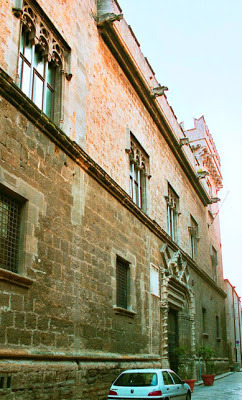
And the architect is Carlo Scarpa who magnificently brought back to life a palace that had been gravely damaged during World War II - like the whole town of Palermo that lost 80 percent of its buildings to bombings.
The art I'm talking about? Here it is, the magnificent head of Eleanor of Aragon by an unknown artist. For many, her smile is as beautiful and enigmatic as the Mona Lisa's - but I prefer her profile:
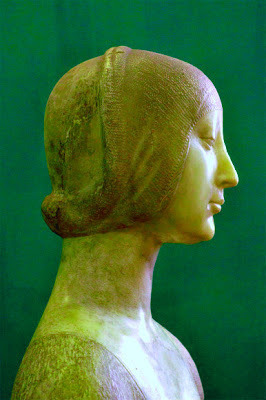
You see her as soon as you walk in. The next high point (after many other artwork) is Antonello da Messina's reading virgin, the extraordinary rendering of a musing young woman as she faces her unique destiny:

And then, the end of the visit comes as a veritable shock. You find yourself looking at a huge fresco, so big that it is composed of four pieces occupying a whole wall (it is in fact 6 by 6.4 meters). It is called Il Trionfo della Morte, The Triumph of Death (a common theme in 14th century Europe) and it used to adorn the entrance of a hospital - I'm not sure to what extent patients felt uplifted by it... Nobody knows who painted it, but it is an absolute world masterpiece, judge for yourself:
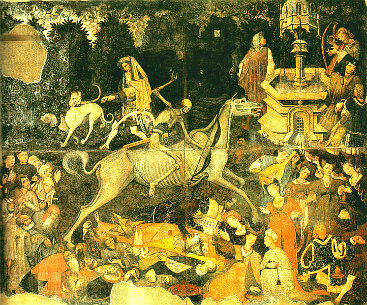
To get the full impact, you'd need to go there and actually stand in front of it. But even from this small image you can get an idea of the violence and beauty of it, a "terrible beauty" to use Yeats' phrase. Just take a close look at the death horse:
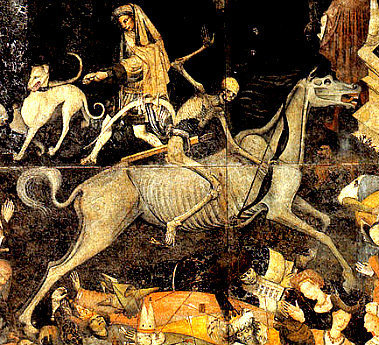
Look at the horse's head. Reminds you of anything? Yes, Picasso's famous Guernica painting - except the head is turned the other way. See here:
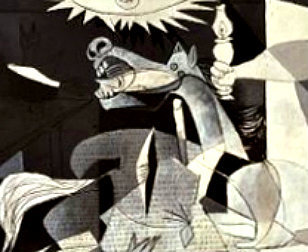
The same violence...
This painting, the Triumph of Death, figures prominently in my novel A Hook in the Sky. When the protagonist visits Palermo with his lover, he learns his mother is dying in Paris just as he is transfixed by the beauty of this painting...The juxtaposition of the painting with the news he's just received on his cell phone traumatizes him.
Don't let that stop you next time you visit Sicily and make sure you include this museum!









The museum is Palazzo Abatellis in Via Alloro, a suggestive old part of town, the Kalsa quarter near the sea. Here it is:

And the architect is Carlo Scarpa who magnificently brought back to life a palace that had been gravely damaged during World War II - like the whole town of Palermo that lost 80 percent of its buildings to bombings.
The art I'm talking about? Here it is, the magnificent head of Eleanor of Aragon by an unknown artist. For many, her smile is as beautiful and enigmatic as the Mona Lisa's - but I prefer her profile:

You see her as soon as you walk in. The next high point (after many other artwork) is Antonello da Messina's reading virgin, the extraordinary rendering of a musing young woman as she faces her unique destiny:

And then, the end of the visit comes as a veritable shock. You find yourself looking at a huge fresco, so big that it is composed of four pieces occupying a whole wall (it is in fact 6 by 6.4 meters). It is called Il Trionfo della Morte, The Triumph of Death (a common theme in 14th century Europe) and it used to adorn the entrance of a hospital - I'm not sure to what extent patients felt uplifted by it... Nobody knows who painted it, but it is an absolute world masterpiece, judge for yourself:

To get the full impact, you'd need to go there and actually stand in front of it. But even from this small image you can get an idea of the violence and beauty of it, a "terrible beauty" to use Yeats' phrase. Just take a close look at the death horse:

Look at the horse's head. Reminds you of anything? Yes, Picasso's famous Guernica painting - except the head is turned the other way. See here:

The same violence...
This painting, the Triumph of Death, figures prominently in my novel A Hook in the Sky. When the protagonist visits Palermo with his lover, he learns his mother is dying in Paris just as he is transfixed by the beauty of this painting...The juxtaposition of the painting with the news he's just received on his cell phone traumatizes him.
Don't let that stop you next time you visit Sicily and make sure you include this museum!









Published on August 21, 2013 01:24
August 20, 2013
Are Heroes Always Tragic Characters?
F. Scott Fitzgerald believed heroes were tragic characters, no doubt a belief that was the expression of a post-World War I mentality:
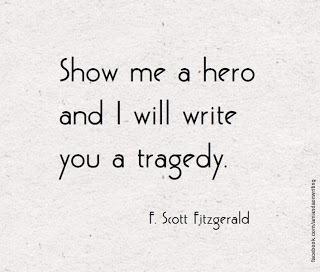
I don't agree.
I can think of many heroes that do not lend themselves to a tragic interpretation of their lives. Or heroins. Think of Florence Nightingale, the 'Lady with the Lamp' because she made rounds of the wounded at night, during the Crimean War:
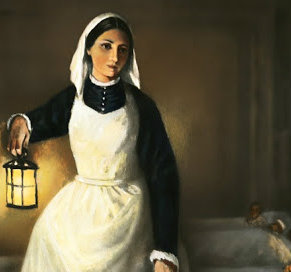
Or Mother Teresa of Calcutta, here with the poor:

Both inspirational lives! And I'm sure there are many more...How about you, can you think of uplifting heroes that would never fit into a tragedy?
Thanks to Amanda Patterson for sharing this literary quote on Facebook.










I don't agree.
I can think of many heroes that do not lend themselves to a tragic interpretation of their lives. Or heroins. Think of Florence Nightingale, the 'Lady with the Lamp' because she made rounds of the wounded at night, during the Crimean War:

Or Mother Teresa of Calcutta, here with the poor:

Both inspirational lives! And I'm sure there are many more...How about you, can you think of uplifting heroes that would never fit into a tragedy?
Thanks to Amanda Patterson for sharing this literary quote on Facebook.









Published on August 20, 2013 01:56
August 19, 2013
The Curious Case of the Publisher Who Hated Writers

We all sometimes hate our jobs, but recently in the UK Guardian, a publisher went overboard, giving vent to his rage and contempt for authors - in principle his lifeline. How could a publisher hate writers when he would have nothing to publish without them? If you're curious to read the piece click here.
And thanks to Passive Voice for drawing my attention to this. His post got over 100 comments (presumably) from irate authors, see here, while the Guardian got less than half the number (only 49).
The arguments put forward are bizarre in themselves. Briefly put:
1. This is a publisher who professes to prefer readers to writers
2. He finds writers are insufferable egotists: while readers are people who want to learn about the world, writers have "made up their mind and seek to deliver the resulting verdict to what they imagine is a waiting world". How idiotic and self-centered can authors be?
3. He believes most writers don't know how to write: "the ability to write well is an attribute not widely shared". Poor writers...Family and friends "irrigate" with ill-founded compliments their belief in a talent they simply do not possess.
4. He has come to the conclusion that writers are publishing worthless stuff, causing a "deluge of writing" that is contributing to "declining readership". In short, "the sheer volume of what is now available acts as a disincentive to settle down with a single text." The phenomenon is "the literary equivalent to channel surfing", only made worse by the tsunami of self-published authors jumping in the publishing pool.
5. Publishing as a business is turned on its head: increasing numbers of writers are paying to be published (through Lulu and all manners of self-publishing means). Writers are "ubiquitous", readers an "endangered species". We're not yet at the point where readers are paid to read, but "it surely isn't far off".
His solution? Writers should take a sabbatical and stop writing for a year! A "moratorium" during which writers could take up hobbies, play golf, hike or even (yikes!) read.
Who's this guy? Colin Robinson is a co-founder of the New York-based independent publisher OR Books. On its site, OR Books claims that it "embraces progressive change in politics, culture and the way to do business". Really? The sweet irony of this claim...
Perhaps Mr. Robinson should take a sabbatical from publishing.
What's your take? My view is that he forgot one important point: writers do NOT necessarily write to promote their own personal views of the world. They write to ENTERTAIN. I know I do. I enjoy the sheer act of writing, of discovering what the characters I have created will do next. Because they do have an unexpected life of their own. They entertain me and in my experience, if that's the case, then they will entertain readers too.
Dammit, publishing is an entertainment industry!
I can't wait to hear your opinion!









Published on August 19, 2013 00:47
August 16, 2013
Is Egypt Sinking in Civil War? The Muslim Brothers Are Burning Christian Churches
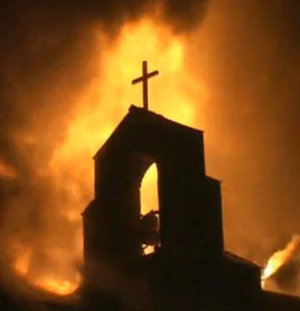
All the signs that Egypt is sinking into a civil war are unfortunately here. Including one that is little noted in the news: the burning of Christian Churches by Muslim Brothers across the country.
The New York Times reported the burning of 2 Coptic churches on August 13, and today, the International Herald Tribune quoted the Egyptian government official figure that admit of 7 churches that were burned. On August 14, the International Christian Concern reported over 20 churches burned , France 24 in its news report last night mentioned 36 churches and examiner.com reported this morning that at last count 52 churches have been attacked.
A terrifying escalation!
And particularly distressing since Christian churches have nothing to do with the on-going crisis. They are collateral damage but a worrying sign of radicalization among the Muslim Brotherhood.
The Arab Spring was supposed to be a revolution of the people who wanted more jobs, health care, education and human dignity. But the grounds of discussion have shifted. Now what we have is rising polarization over the role of religion in public life.
If dialogue cannot be established with all parties, the next step, alas, is civil war.









Published on August 16, 2013 00:24



